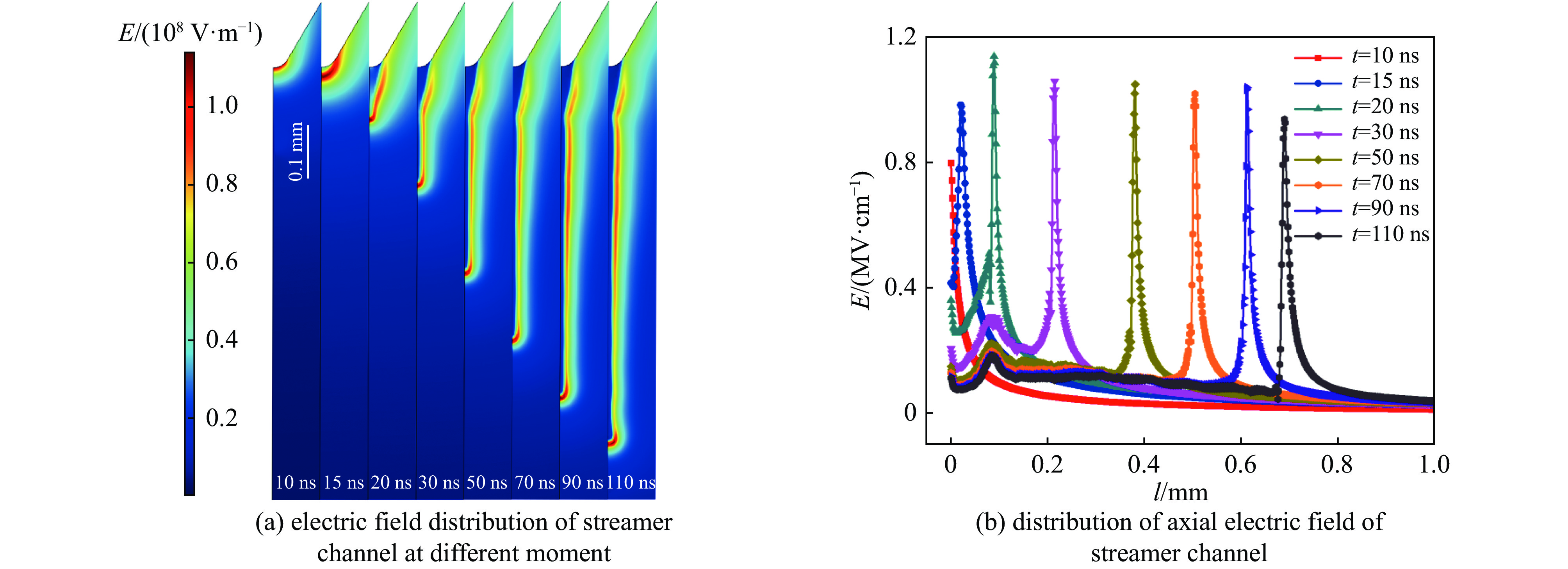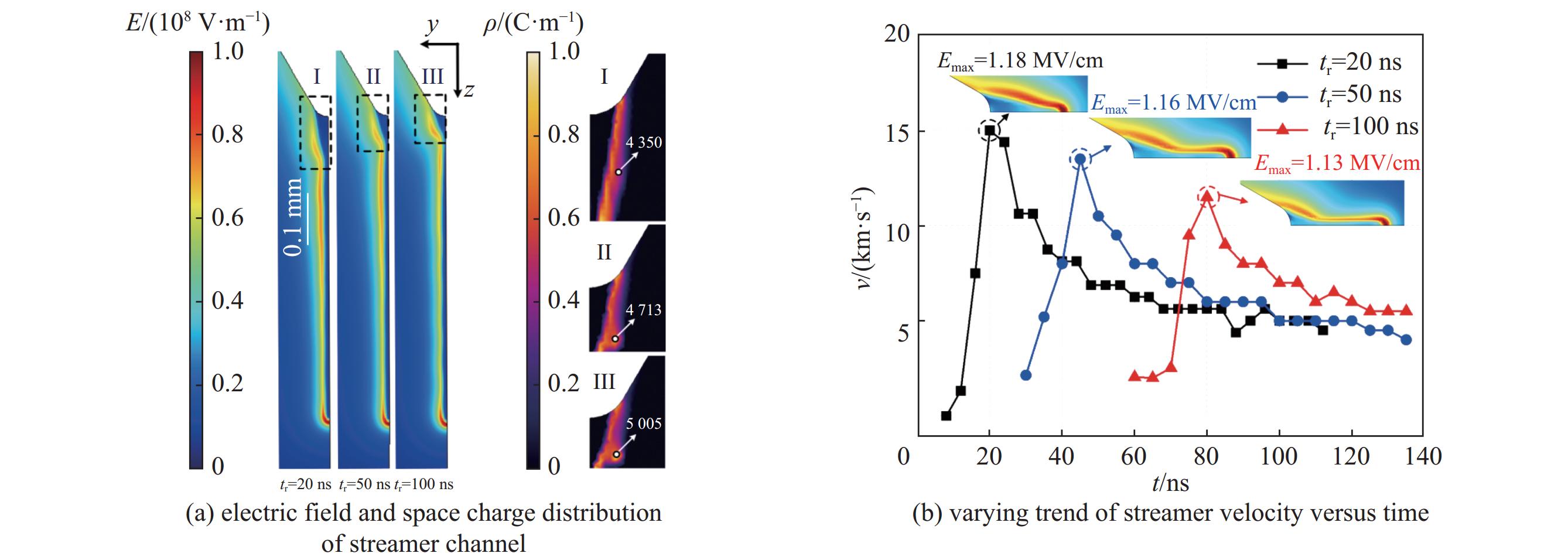Propagation characteristics of positive filamentary streamer discharges in water
-
摘要: 水中流注放电为击穿前放电通道起始与发展的关键过程,但由于涉及物理机制较为复杂且尚不明确,制约了水中放电应用效率的提升。探究了水中正极性丝状流注放电的模式转化特性、重燃特性与分叉特性,明确了通道界面沉积电荷与空间电荷分布对流注发展过程的影响。研究结果表明,水中正极性放电可分为第一类与第二类丝状流注,流注模式转化特性受气液界面电荷弛豫过程影响较大。当外施电压达到加速电压时,第一类流注迅速转化为第二类流注。第一类丝状流注通道内电离形成、熄灭及重燃过程与通道内部电场及气/液界面电荷密度关系密切。第二类丝状流注通道空间电荷分布受电压上升沿与电极表面结构影响较大。电压上升沿时间越长,主通道头部电荷密度与电场强度越低,通道发展速度随之降低。随电极表面微凸结构半径增大,流注分叉点位置将电极表面过渡为主通道根部。受主通道空间电荷分布影响,分支通道发展速度在微凸结构半径为5 μm时呈现先降后升趋势。Abstract: Positive underwater discharge can produce abundant physical and chemical effects and is widely used in the fields of energy source exploration and sterilization. However, the physical mechanisms involved in initiation and propagation of streamer are complex and have not been fully revealed, which limit the efficiency of underwater discharge applications. In this paper, we explore the mode-transition, reillumination and branching characteristics of positive filamentary streamer. The influence of deposited charge and space charge distribution on the propagation of streamer channel is clarified. Our research shows that the positive polarity filamentary streamers can be divided into primary streamer and secondary streamer, and the mode transition of discharges is greatly affected by the gas/liquid interface charge relaxation process. When the applied voltage reaches the accelerating voltage, the primary streamer rapidly transits into secondary streamer. The gas/liquid interface charge density and electric field in primary streamer channel are closely related with initiation, termination and reignition of discharge. The space charge distribution of secondary streamer is greatly affected by the voltage rising edge and the electrode surface structure. Longer voltage rise time leads to lower density of space charge and electric field at the head of streamer channel, which causes the decrease of streamer velocity. With larger radius of the micro-convex structure on the electrode surface, the branching of streamer will take place at the root of the main channel instead of electrode surface. Due to the variation of the spatial charge distribution, the velocity of the branching channel shows a trend of first declining and then increasing when the radius of the micro-convex structure is 5 μm.
-
Key words:
- liquid discharge /
- streamer discharge /
- discharge mode /
- interface charge /
- streamer branching
-
表 1 水中流注放电仿真模型的主要物理参数
Table 1. Main physical parameters of underwater streamer discharge simulation model
h/(J·s) a/m n0/m−3 Δ/eV m*/kg Rpn/(m3/s) Rpe/(m3/s) μp/(m2·V-1·s-1) μn/(m2·V-1·s-1) μe/(m2·V-1·s-1) τa/ns ε0/(F/m) εr e/C 6.63×10−34 3.1×10−10 3.3×1026 4.0 9.1×10−32 1×10−19 1×10−19 3.5×10−7 2×10−7 5×10−4 200 8.85×10−12 81 1.6×10−19 -
[1] 李元, 郜晶, 朱光远, 等. 液相等离子体技术制备碳纳米材料的进展与趋势[J]. 中国电机工程学报, 2021, 41(8):2909-2918Li Yuan, Gao Jing, Zhu Guangyuan, et al. Advances and trends of carbon nanomaterial synthesis by liquid-plasma processing[J]. Proceedings of the CSEE, 2021, 41(8): 2909-2918 [2] 朱太云, 张乔根, 杨兰均, 等. 水中脉冲放电产生过氧化氢及其影响因素[J]. 强激光与粒子束, 2010, 22(3):675-678 doi: 10.3788/HPLPB20102203.0675Zhu Taiyun, Zhang Qiaogen, Yang Lanjun, et al. Generation of hydrogen peroxide by pulse discharge in water and its affecting factors[J]. High Power Laser and Particle Beams, 2010, 22(3): 675-678 doi: 10.3788/HPLPB20102203.0675 [3] 付荣耀, 孙鹞鸿, 刘坤, 等. 大水泥岩样的电脉冲压裂实验研究[J]. 强激光与粒子束, 2018, 30:045007 doi: 10.11884/HPLPB201830.170347Fu Rongyao, Sun Yaohong, Liu Kun, et al. Experimental study of fracturing under electric pulse for large cement sample[J]. High Power Laser and Particle Beams, 2018, 30: 045007 doi: 10.11884/HPLPB201830.170347 [4] 严辉, 黄逸凡, 裴彦良, 等. 等离子体震源及在海洋勘探中的应用[J]. 高电压技术, 2012, 38(7):1711-1718Yan Hui, Huang Yifan, Pei Yanliang, et al. Plasma seismic source and its application in oceanic seismic exploration[J]. High Voltage Engineering, 2012, 38(7): 1711-1718 [5] 韩若愚, 李柳霞, 钱盾, 等. 液体中金属丝电爆炸的研究现状与展望[J]. 高电压技术, 2021, 47(3):766-777Han Ruoyu, Li Liuxia, Qian Dun, et al. Exploding metal wires in liquids: current situation and prospects[J]. High Voltage Engineering, 2021, 47(3): 766-777 [6] 李显东, 刘毅, 周古月, 等. 针–板电极下水中亚音速流注形态与发展过程[J]. 中国电机工程学报, 2018, 38(5):1562-1571Li Xiandong, Liu Yi, Zhou Guyue, et al. Morphology and development of underwater subsonic streamer under needle to plane electrodes[J]. Proceedings of the CSEE, 2018, 38(5): 1562-1571 [7] 赵景林, 王志强, 王进君, 等. 基于Kriging模型的水中放电沉积能量优化分析[J]. 强激光与粒子束, 2023, 35:035005 doi: 10.11884/HPLPB202335.220240Zhao Jinglin, Wang Zhiqiang, Wang Jinjun, et al. Deposited energy optimization analysis of discharge in water based on Kriging model[J]. High Power Laser and Particle Beams, 2023, 35: 035005 doi: 10.11884/HPLPB202335.220240 [8] 李元, 温嘉烨, 李林波, 等. 液体介质微/纳秒脉冲放电的特性与机理: 现状及进展[J]. 强激光与粒子束, 2021, 33:065001 doi: 10.11884/HPLPB202133.210190Li Yuan, Wen Jiaye, Li Linbo, et al. Characteristics and mechanisms of streamer discharge in liquids under micro/nano-second pulsed voltages: status and advances[J]. High Power Laser and Particle Beams, 2021, 33: 065001 doi: 10.11884/HPLPB202133.210190 [9] 温嘉烨, 李元, 倪正全, 等. 水中负极性灌木状放电特性研究[J]. 中国电机工程学报, 2021, 41(17):6108-6115Wen Jiaye, Li Yuan, Ni Zhengquan, et al. Study on characteristics of negative bushy discharges in water[J]. Proceedings of the CSEE, 2021, 41(17): 6108-6115 [10] Kumagai R, Kanazawa S, Ohtani K, et al. Propagation and branching process of negative streamers in water[J]. Journal of Applied Physics, 2018, 124: 163301. doi: 10.1063/1.5025376 [11] Lesaint O. Prebreakdown phenomena in liquids: propagation ‘modes’ and basic physical properties[J]. Journal of Physics D: Applied Physics, 2016, 49: 144001. doi: 10.1088/0022-3727/49/14/144001 [12] 孙冰. 液相放电等离子体及其应用[M]. 北京: 科学出版社, 2013Sun Bing. Discharge plasma in liquid and its applications[M]. Beijing: Science Press, 2013 [13] Li Yuan, Wen Jiaye, Jiang Qiuyu, et al. Influences of discharge modes and gas bubbling conditions on E. coli sterilization by pulsed underwater discharge treatments[J]. AIP Advances, 2020, 10: 025207. doi: 10.1063/1.5126378 [14] Fujita H, Kanazawa S, Ohtani K, et al. Initiation process and propagation mechanism of positive streamer discharge in water[J]. Journal of Applied Physics, 2014, 116: 213301. doi: 10.1063/1.4902862 [15] Wen Jiaye, Li Yuan, Li Linbo, et al. Experimental observations and interpretations of bubble-induced discharges under microsecond pulsed voltages in water[J]. Journal of Physics D: Applied Physics, 2020, 53: 425208. doi: 10.1088/1361-6463/ab9f67 [16] Fujita H, Kanazawa S, Ohtani K, et al. Fast propagation of an underwater secondary streamer by the appearance of a continuous component in the discharge current[J]. Europhysics Letters, 2014, 105: 15003. doi: 10.1209/0295-5075/105/15003 [17] 王芝, 韩若愚, 李显东, 等. 水中针-板结构小能量脉冲火花放电特性[J]. 强激光与粒子束, 2022, 34:095006 doi: 10.11884/HPLPB202234.220022Wang Zhi, Han Ruoyu, Li Xiandong, et al. Low-energy pulsed spark discharge characteristics of pin-plate structure in water[J]. High Power Laser and Particle Beams, 2022, 34: 095006 doi: 10.11884/HPLPB202234.220022 [18] Jadidian J, Zahn M, Lavesson N, et al. Stochastic and deterministic causes of streamer branching in liquid dielectrics[J]. Journal of Applied Physics, 2013, 114: 063301. doi: 10.1063/1.4816091 [19] Qian J, Joshi R P, Schamiloglu E, et al. Analysis of polarity effects in the electrical breakdown of liquids[J]. Journal of Physics D: Applied Physics, 2006, 39(2): 359-369. doi: 10.1088/0022-3727/39/2/018 [20] Aghdam A C, Farouk T. Multiphysics simulation of the initial stage of plasma discharge formation in liquids[J]. Plasma Sources Science and Technology, 2020, 29: 025011. doi: 10.1088/1361-6595/ab51e3 [21] Top T V, Lesaint A. Streamer initiation in mineral oil. Part II: influence of a metallic protrusion on a flat electrode[J]. IEEE Transactions on Dielectrics and Electrical Insulation, 2002, 9(1): 92-96. doi: 10.1109/94.983891 -





 下载:
下载:













